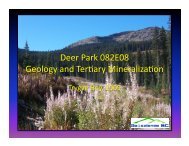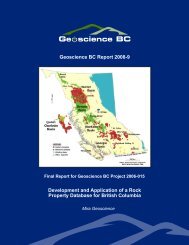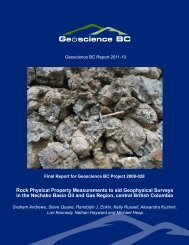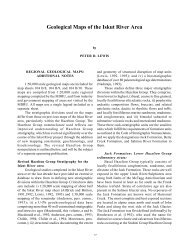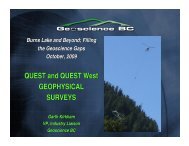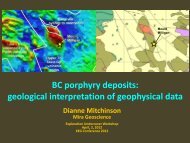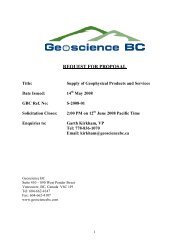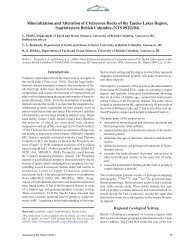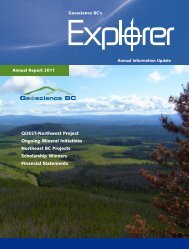HORN RIVER BASIN Subsurface Aquifer ... - Geoscience BC
HORN RIVER BASIN Subsurface Aquifer ... - Geoscience BC
HORN RIVER BASIN Subsurface Aquifer ... - Geoscience BC
You also want an ePaper? Increase the reach of your titles
YUMPU automatically turns print PDFs into web optimized ePapers that Google loves.
<strong>HORN</strong> <strong>RIVER</strong> <strong>BASIN</strong><br />
<strong>Subsurface</strong> <strong>Aquifer</strong> Characterization Project<br />
Brad J. Hayes<br />
Petrel Robertson Consulting Ltd.
ACKNOWLEDGEMENTS<br />
• Horn River Basin Producers Group<br />
• <strong>Geoscience</strong> <strong>BC</strong><br />
• <strong>BC</strong> Ministry of Energy, Mines, and Petroleum Resources<br />
• Subcontractors<br />
– Canadian Discovery Ltd.<br />
– JC Consulting Inc., JMS Geological Consulting
<strong>HORN</strong> <strong>RIVER</strong> <strong>BASIN</strong> AQUIFER CHARACTERIZATION PROJECT<br />
INTRODUCTION<br />
• Horn River Basin Devonian shale gas play is one of North America’s largest<br />
and hottest shale gas “resource” plays<br />
– All acreage is subject to intensive development by multi‐leg horizontal wells,<br />
each leg stimulated by multiple staged fracs<br />
• Large volumes of water will be required –up to 4000m 3 per frac<br />
– Spent (contaminated) frac waters must be safely disposed<br />
• Deep subsurface aquifers are ideal sources and sinks<br />
– Non‐potable water, far below water table and surface waters<br />
– Shallower aquifers, such as Quaternary (glacial) paleovalleys, may represent<br />
short‐term water sources, but may not be suitable for disposal<br />
– Producers do not want to use surface water sources, and cannot dispose of<br />
spent fluids at the surface
<strong>HORN</strong> <strong>RIVER</strong> <strong>BASIN</strong> AQUIFER CHARACTERIZATION PROJECT<br />
PROJECT OBJECTIVES and GOALS<br />
OBJECTIVE:<br />
• Determine distribution and capacity of deep subsurface, non‐potable aquifers<br />
in the HRB as:<br />
• Potential sources of water for shale gas completions<br />
• Potential disposal sites for water produced during shale gas completions and<br />
production<br />
GOALS:<br />
• To contribute information to help in planning the orderly development of the<br />
HRB shale gas resources<br />
• To help reduce the overall environmental impact of unconventional gas<br />
development in the HRB<br />
NOTE:<br />
• This project complements other water‐related research work being developed<br />
by HRBPG, including water recycling, and surface water quality and budget<br />
monitoring and assessment
94-J-11<br />
94-P-14<br />
94-I-11<br />
<strong>HORN</strong> <strong>RIVER</strong> <strong>BASIN</strong><br />
• Slave Point / Keg River platform to<br />
south and east<br />
• Bovie Fault Zone to west<br />
AQUIFER PROJECT DATA<br />
• 556 wells<br />
• 16 regional cross‐sections<br />
• 60 cores logged<br />
• Sample cuttings from 63 wells<br />
• DST and water test data<br />
• numerous tests outside the<br />
basin to establish regional<br />
trends
<strong>HORN</strong> <strong>RIVER</strong> <strong>BASIN</strong><br />
SCHEMATIC CROSS‐SECTION<br />
LIARD <strong>BASIN</strong><br />
Bovie<br />
<strong>HORN</strong> <strong>RIVER</strong> <strong>BASIN</strong><br />
West<br />
Fault<br />
Zone<br />
East
LIARD <strong>BASIN</strong><br />
STRUCTURE<br />
TOP BANFF FM<br />
• Much deeper westward in<br />
Liard Basin (across Bovie<br />
Fault System)
<strong>HORN</strong> <strong>RIVER</strong> <strong>BASIN</strong><br />
PRIMARY RESERVOIR UNITS<br />
• Mississippian carbonate platform<br />
• Local reservoir development<br />
within cycles<br />
• More consistent and higher‐<br />
quality reservoir at upper surface<br />
in “Detrital” zone<br />
• Mattson sandstones (not shown)<br />
• to west in Bovie Fault Zone and<br />
Liard Basin<br />
• Cretaceous sandstones<br />
• Gething to east<br />
• Bluesky to southeast<br />
• Chinkeh (not shown) in Liard Basin
BANFF FORMATION<br />
• Distal carbonate mudstones<br />
• Limited clastic component (sltst –vf sst) to top<br />
• develops limited reservoir capacity<br />
where diagenetically enhanced at<br />
pre‐Cretaceous unconformity<br />
• NOT an aquifer target in Horn River Basin
PEKISKO FORMATION<br />
• Clean bioclastic limestone<br />
• Marks base of Mississippian carbonate<br />
platform<br />
• Tightly cemented, develops reservoir<br />
quality only locally beneath pre‐<br />
Cretaceous unconformity<br />
• NOT an aquifer target in Horn River Basin
Φ K<br />
25 m<br />
Debolt<br />
RUNDLE / DEBOLT<br />
• Correlated on flooding surface markers<br />
in Horn River Basin<br />
• Elkton / Shunda cannot be carried with<br />
confidence from southern areas<br />
• Stacked shoaling‐upward carbonate<br />
cycles form carbonate platform<br />
• dominantly mudstones to wackestones /<br />
packstones; little primary porosity<br />
• upper parts of cycles are dolomitized in<br />
middle of platform, in isolated wells
Φ K<br />
50 ft<br />
250’ to pKU<br />
Debolt<br />
Upper<br />
Rundle<br />
RUNDLE / DEBOLT<br />
• Correlated on flooding surface markers<br />
in Horn River Basin<br />
• Elkton / Shunda cannot be carried with<br />
confidence from southern areas<br />
• Stacked shoaling‐upward carbonate<br />
cycles form carbonate platform<br />
• dominantly mudstones to wackestones /<br />
packstones; little primary porosity<br />
• upper parts of cycles are dolomitized in<br />
middle of platform in isolated wells
ISOPACH<br />
MIDDLE RUNDLE<br />
• Subcrops east of HRB<br />
• Cannot distinguish from<br />
remainder of Rundle and Debolt<br />
to west
ISOPACH<br />
UPPER RUNDLE<br />
• Subcrops at eastern margin<br />
of HRB<br />
• Cannot distinguish from<br />
remainder of Rundle and Debolt<br />
to west
ISOPACH<br />
DEBOLT FORMATION<br />
• Pre‐Cretaceous valley incision<br />
influences subcrop edge<br />
• Cannot distinguish from<br />
underlying Rundle to west
<strong>HORN</strong> <strong>RIVER</strong> <strong>BASIN</strong><br />
PRIMARY RESERVOIR UNITS<br />
• Best quality and most continuous<br />
reservoir is associated with the<br />
weathered interval capping the<br />
Mississippian carbonate platform,<br />
beneath the pre‐Cretaceous<br />
unconformity<br />
• “Detrital zone”
Φ K<br />
Debolt<br />
Upper<br />
Rundle<br />
25 m<br />
DETRITAL ZONE<br />
• Extensive and intensive dolomitization<br />
at pre‐Cretaceous unconformity<br />
• Poor core and sample recovery<br />
• Poor log characterization –washed out
d-92-H / 94-O-9<br />
Gamma PE Density SP Resis<br />
DETRITAL ZONE<br />
• Extensive and intensive dolomitization<br />
at pre‐Cretaceous unconformity<br />
• Poor core and sample recovery<br />
• Poor log characterization –washed out
Regional fracturing<br />
(Giant Springs, Great Falls)<br />
DETRITAL ZONE OUTCROP ANALOGUE<br />
Madison Group, Northern Montana<br />
Solution breccia, dolomitization, recrystallization
MATTSON FORMATION<br />
• Stacked fluvial –deltaic sandstones<br />
• Good primary reservoir quality<br />
• Variably cemented by silica and carbonate;<br />
local degradation by bitumen<br />
• Present only on western margin of HRB
Mattson Formation<br />
(Jackfish Gap, Yukon Territory)
ISOPACH<br />
MATTSON FORMATION<br />
• Present only in Bovie Fault Zone,<br />
thickens rapidly westward<br />
• May be aquifer target in extreme<br />
western part of shale gas area
Debolt clast<br />
GETHING FORMATION<br />
• Fills south‐north trending valley on eastern<br />
flank of HRB<br />
• incises eastern margin of Debolt<br />
• Abundant poorly‐sorted detritus<br />
• Variable reservoir quality, but some good<br />
rock in most wells<br />
• Hydrodynamic connection with Debolt
BLUESKY FORMATION<br />
• West‐east trending shoreface on<br />
southeastern flank of HRB<br />
• Grades westward to offshore deposits<br />
• Good reservoir quality only in southeast<br />
• Unlikely to be an important aquifer –<br />
moderate quality, away from main<br />
gas shale target areas<br />
Truncated Rosselia burrow
CHINKEH FORMATION<br />
• Fluvial to marginal marine / shoreface<br />
• Mapped throughout Liard Basin<br />
• found locally in far northwestern<br />
corner of HRB<br />
• Generally modest reservoir quality<br />
• Unlikely to be important aquifer –<br />
moderate quality, too far west<br />
• possibly local importance in<br />
NW 94‐O‐15, if reservoir volume is<br />
sufficient
CHINKEH<br />
GETHING<br />
BLUESKY<br />
ISOPACH<br />
CRETACEOUS SANDSTONES<br />
• Gething valley fill to east<br />
• Bluesky shoreface to southeast<br />
• Chinkeh fluvial / deltaic to west<br />
(Liard Basin)
<strong>HORN</strong> <strong>RIVER</strong> <strong>BASIN</strong> AQUIFER CHARACTERIZATION PROJECT<br />
RESERVOIR ROCK SUMMARY<br />
• Mississippian carbonate platform<br />
– Limited reservoir quality in shoaling‐up cycles in middle to upper Rundle and<br />
Debolt<br />
– Local dolomitization / solution enhances reservoir quality in upper parts of cycles<br />
– Capping “detrital zone” exhibits widespread and generally good to excellent<br />
reservoir quality<br />
• Mattson Formation<br />
– Variable but generally good reservoir quality<br />
– Thickens sharply westward from Bovie Fault Zone; absent in HRB<br />
• Cretaceous sandstones<br />
– Gething valley fill (eastern flank) relatively thin, but has some good reservoir<br />
– Bluesky shoreface (southeast) –moderate reservoir quality, only locally developed<br />
– Chinkeh Formation (western flank) –moderate reservoir quality, possible local<br />
importance in far northwest
<strong>HORN</strong> <strong>RIVER</strong> <strong>BASIN</strong> AQUIFER CHARACTERIZATION PROJECT<br />
RESERVOIR QUALITY MAPPING<br />
• Quantification of aquifer potential a product of reservoir thickness and<br />
quality: porosity‐thickness maps<br />
• Mattson and Cretaceous sandstones quantified using standard log<br />
porosity cutoffs<br />
– Mattson 6% Φ cutoff (generally fine‐grained)<br />
– Cretaceous 3% Φ cutoff (coarser‐grained)<br />
• “Detrital” carbonates more difficult to quantify<br />
– Variable mineralogy, fracturing, and heterogeneity render porosity logs only<br />
qualitative indicators of reservoir quality<br />
– Classify reservoir as excellent / good / poor based on sample cuttings logs,<br />
well logs, and wellsite cuttings logs (approx. 3/6/9% Φ cutoffs)<br />
– Calculate Φ‐h as:<br />
• Enhanced reservoir thickness (m) x reservoir quality porosity cutoff value
NET POROUS ISOPACH<br />
MATTSON FORMATION<br />
• 6% Φ cutoff<br />
• >100 metres of 6% (+) sst a few<br />
km west of HRB shale gas<br />
project areas, but none within<br />
current developments
POROSITY‐THICKNESS<br />
CRETACEOUS SANDSTONES<br />
• 3% Φ cutoff<br />
• Patchy reservoir in Gething valley<br />
• High‐porosity Bluesky in SE<br />
is in fine‐grained rock with lower<br />
perms, and is southeast of<br />
most gas shale projects<br />
• Lateral extent of high‐quality<br />
Chinkeh in northwest is not clear,<br />
but may impact local gas shale<br />
projects
POROSITY ‐ THICKNESS<br />
“DETRITAL ZONE”<br />
• Major N‐S fairway associated<br />
with Debolt subcrop edge and<br />
Gething valley incision<br />
• values range up to 4.0 Φ‐m<br />
(>40 m of 9% Φ)<br />
• Other thicks along eastern<br />
margin may be associated<br />
subcrop of particular units<br />
• Does local structure assist in<br />
reservoir enhancement along<br />
southerly Slave Point margin<br />
and Bovie Fault Zone ?<br />
• Almost no well control in<br />
western half of HRB
POROSITY ‐ THICKNESS<br />
CARBONATE PLATFORM<br />
(Total enhanced reservoir)<br />
• “Detrital” zone values dominate,<br />
but good reservoir in lower<br />
zones is locally important
<strong>HORN</strong> <strong>RIVER</strong> <strong>BASIN</strong> AQUIFER CHARACTERIZATION PROJECT<br />
HYDROGEOLOGY<br />
• Canadian Discovery Ltd. compiled and analyzed DST and<br />
pumping / injection data<br />
– Most available data is from outside HRB, and is used to provide regional<br />
context<br />
– Supplemental test data collection within HRB, from new wells drilled by<br />
HRBPG members, was coordinated and partly financed by <strong>Geoscience</strong> <strong>BC</strong><br />
• Created hydrogeological analysis for HRB aquifers, tied to stratigraphy<br />
developed by Petrel Robertson<br />
– Hydrostratigraphic units –P/E plots, hydraulic head maps<br />
– Fluid chemistry<br />
– Reservoir injectivity and flow capacity
Elevation<br />
Pressure<br />
Devonian<br />
Hi-P Devonian<br />
Pressure –Elevation Plots<br />
Cretaceous –Lower Rundle Hydrostratigraphic Unit<br />
• Bounded by Cretaceous Buckinghorse Shale and Banff Fm<br />
• Single, well‐defined water gradient<br />
• normally‐ to slightly under‐pressured<br />
• Regional extent –much larger than Horn River Basin<br />
• numerous associated gas and oil pools<br />
Mattson Formation<br />
• Water gradient distinct from Cretaceous – Rundle<br />
• Insufficient data to define upper and lower<br />
boundaries of hydrostratigraphic unit
Bovie Fault Zone<br />
30,000<br />
Total Dissolved Solids (mg/L)<br />
15,000<br />
20,000<br />
25,000<br />
40,000<br />
Cretaceous – Rundle<br />
Hydrostratigraphic Unit<br />
Water Salinity<br />
Formation water TDS<br />
15,000 – 40,000 mg/l<br />
• Much too saline to be<br />
potable, but still OK for<br />
use as completion fluid<br />
• Values similar across<br />
entire vertical section
Bovie Fault Zone<br />
x<br />
x x<br />
x<br />
xx<br />
x<br />
x<br />
x x<br />
x<br />
x<br />
x<br />
x<br />
x<br />
x<br />
Cretaceous – Rundle<br />
Hydrostratigraphic Unit<br />
H 2 S Concentration<br />
Very low H 2 S concentrations<br />
in Rundle / Debolt<br />
• Most
27 e 6 m 3 / section<br />
10 e 6 m 3 / section<br />
Debolt – Rundle<br />
<strong>Aquifer</strong><br />
Water Volumes in Place<br />
Assumptions:<br />
• Average porosity = 2%<br />
• “Enhanced” porosity = 9%<br />
Total water volume – 95 e 9 m 3<br />
- 15 e 9 m 3 in “enhanced” rock
Pumping / Injection Data<br />
DST Data<br />
Core Data<br />
Debolt/Rundle Porosity-Thickness Map<br />
Debolt – Rundle <strong>Aquifer</strong><br />
Permeability<br />
P/I tests all located where<br />
“enhanced” reservoir exists<br />
• All except one show K > 1000 mD<br />
• Maximum 39,800 mD<br />
Core and DST results show<br />
K < 10 mD in regional strata
<strong>HORN</strong> <strong>RIVER</strong> <strong>BASIN</strong> AQUIFER CHARACTERIZATION PROJECT<br />
CONCLUSIONS (1)<br />
• Stratigraphic analysis shows three subsurface units with aquifer potential:<br />
– Mississippian carbonate platform<br />
– Mattson Formation<br />
– Cretaceous sandstones<br />
• Best quality and most continuous reservoir in “detrital” unit capping<br />
Mississippian carbonates, particularly associated with Debolt subcrop<br />
edge (and pre‐Gething valley incision)<br />
– Very little well control in western half of HRB –is this unit more widespread?<br />
– Existing data support only semi‐quantitative reservoir quality assessment<br />
• Local Φ‐h thicks in west associated with Mattson and Chinkeh
<strong>HORN</strong> <strong>RIVER</strong> <strong>BASIN</strong> AQUIFER CHARACTERIZATION PROJECT<br />
CONCLUSIONS (2)<br />
• Mississippian carbonates and Cretaceous sands occur within a single<br />
hydrostratigraphic unit<br />
– Mattson sands geographically separated, on a different water gradient<br />
• Waters are saline, but suitable for use as completion fluid<br />
– Low concentrations of sour gas seen in Mississippian waters –requires further<br />
assessment<br />
• Extremely high permeabilities occur in Mississippian “detrital” unit<br />
– Flow/injectivity tests, DST’s, cuttings samples, well logs<br />
– Mappable along Φ‐h fairways<br />
• Relatively limited reservoir potential in sandstone aquifers<br />
– Potential local “sweet spots” in Mattson and Chinkeh
<strong>HORN</strong> <strong>RIVER</strong> <strong>BASIN</strong><br />
<strong>Subsurface</strong> <strong>Aquifer</strong> Characterization Project<br />
Brad J. Hayes<br />
Petrel Robertson Consulting Ltd.





